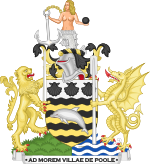
Heraldry is a discipline relating to the design, display and study of armorial bearings, as well as related disciplines, such as vexillology, together with the study of ceremony, rank and pedigree. Armory, the best-known branch of heraldry, concerns the design and transmission of the heraldic achievement. The achievement, or armorial bearings usually includes a coat of arms on a shield, helmet and crest, together with any accompanying devices, such as supporters, badges, heraldic banners and mottoes.

Poole is a large coastal town and seaport in Dorset, on the south coast of England. The town is 21 miles (34 km) east of Dorchester and adjoins Bournemouth to the east. Since 1 April 2019, the local authority is Bournemouth, Christchurch and Poole Council which is a unitary authority. Poole had an estimated population of 151,500 making it the second-largest town in the ceremonial county of Dorset. Together with Bournemouth and Christchurch, the conurbation has a total population of nearly 400,000.

The coat of arms of Toronto, Ontario, Canada, was designed by Robert Watt, the Chief Herald of Canada at the time, for the City of Toronto after its amalgamation in 1998. The arms were granted by the Canadian Heraldic Authority on 11 January 1999.

The most basic rule of heraldic design is the rule of tincture: metal should not be put on metal, nor colour on colour. This means that the heraldic metals or and argent should not be placed on each other, nor may any of the colours be placed on another colour. Heraldic furs as well as "proper" are exempt from the rule of tincture.

The City and County of Swansea Council is the governing body for one of the Principal Areas of Wales covering Swansea, Gower and the surrounding area. The council consists of 75 councillors representing 32 electoral wards.

The Coat of arms of Leeds City Council derives its design from the seventeenth century. In 1662 the Borough of Leeds received a new charter which created the office of mayor, and the arms seems to date from about this time as they incorporate part of the arms of the first mayor. These arms were recorded at the heraldic visitation of Yorkshire in 1666. By the time that the borough was reformed by the Municipal Corporations Act 1835, silver owls had been added both as crest above the shield, and as supporters on either side. These additions were not authorised, however, and in 1920 application was made by Leeds County Borough Council to the College of Arms to have these additions officially granted. In the following year the grant of crest and supporters was made, with the colouring of the owls altered to "proper", or natural colourings. Gold ducal coronets were added to the supporters for further heraldic difference.

The coat of arms of Wigan Metropolitan Borough Council was granted by the College of Arms in 1974.

The coat of arms of York is the official symbol of City of York Council, the local government of the City of York, England. The borough has been extended a number of times from the original city contained within the city walls. However, the arms have remained the same throughout all these changes to the borough.

Bournemouth Borough Council was the local authority of Bournemouth in Dorset, England and ceased to exist on 1 April 2019. It was a unitary authority, although between 1974 and 1997 it was an administrative district council with Dorset. Previously most of the borough was part of Hampshire.
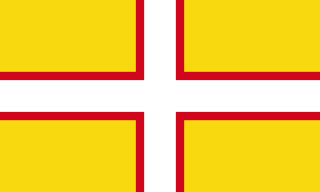
The flag of Dorset is the flag of the English county of Dorset. It was chosen as the flag of Dorset on 16 September 2008 following a vote open to all Dorset residents, and organised by Dorset County Council. The unitary authorities of Bournemouth and Poole declined an invitation to participate. The flag has subsequently been registered at the Flag Institute and added to their UK Flags Register.

English heraldry is the form of coats of arms and other heraldic bearings and insignia used in England. It lies within the so-called Gallo-British tradition. Coats of arms in England are regulated and granted to individuals by the English kings of arms of the College of Arms. An individual's arms may also be borne ‘by courtesy' by members of the holder's nuclear family, subject to a system of cadency marks, to differentiate those displays from the arms of the original holder. The English heraldic style is exemplified in the arms of British royalty, and is reflected in the civic arms of cities and towns, as well as the noble arms of individuals in England. Royal orders in England, such as the Order of the Garter, also maintain notable heraldic bearings.
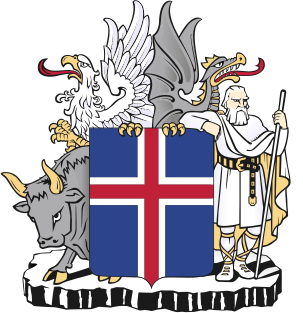
Icelandic heraldry is the study of coats of arms and other insignia used in Iceland. It belongs to the German-Nordic heraldic tradition, as the heraldry of Iceland has been primarily influenced by the heraldic traditions of Norway, Denmark and other Nordic countries. Iceland does not have a strong sense of heraldic tradition, however, because the country lacks a governing body to oversee this. As a result, coats of arms registered as such are virtually nonexistent in modern Iceland. While many municipalities use more or less heraldic logos, there are no heraldic standards to which these must adhere, and they are registered as graphic designs rather than as coats of arms.
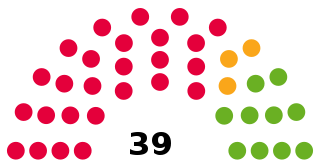
Norwich City Council is the city council for the city of Norwich, Norfolk, England. It consists of 39 councillors, elected to represent 13 wards, each with three councillors. It is currently under Labour control and led by Alan Waters. It forms the lower tier of local government in Norwich, responsible for local services such as housing, planning, leisure and tourism.

The coat of arms of Newport is the heraldic emblem of the city of Newport, South Wales. Also known as the Civic Badge, it has been borne by the present Newport City Council since 24 July 1996 following the municipal reorganisation in April that year.

The coat of arms of the London Borough of Bromley is the official coat of arms of the London Borough of Bromley, granted on 20 April 1965.

The coat of arms of the London Borough of Camden were granted on 10 September 1965. The borough was formed by the merger of three former boroughs, namely the Metropolitan Borough of Hampstead, the Metropolitan Borough of Holborn and the Metropolitan Borough of St. Pancras, from whose arms elements were utilised in the arms of the new borough.

Bournemouth, Christchurch and Poole (BCP) is a unitary authority area in the ceremonial county of Dorset, England. It was created on 1 April 2019 by the merger of the areas that were previously administered by the unitary authorities of Bournemouth and Poole, and the non-metropolitan district of Christchurch. The authority covers much of the area of the South Dorset conurbation.
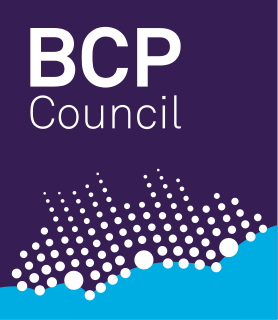
Bournemouth, Christchurch and Poole Council is a unitary local authority for the district of Bournemouth, Christchurch and Poole in England that came into being on 1 April 2019. It was created from the areas that were previously administered by the unitary authorities of Bournemouth and Poole and the non-metropolitan district of Christchurch.

The 2019 Bournemouth, Christchurch and Poole Council election took place on 2 May 2019 to elect the inaugural members of Bournemouth, Christchurch and Poole Council in England, formed from the former unitary authorities of Bournemouth and Poole, and borough of Christchurch. At the same time an election for the new Christchurch Town Council was held.
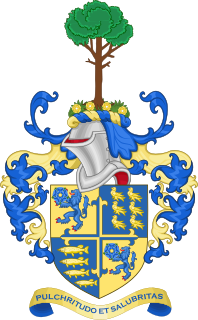
The coat of arms of Bournemouth was first granted on 24 March 1891. The crest consists of four English roses surmounted by a pine tree. The motto is Pulchritudo et Salubritas, Latin for "beauty and health". The colours of the shield, the main part of the coat of arms, are taken from the royal arms of King Edward the Confessor, in whose royal estate the area now known as Bournemouth was situated. The four salmon represent those to be found in the River Stour, which marks the boundary between Christchurch and Bournemouth. Each of the lions holds a rose between ts paws. The six birds, also taken from Edward the Confessor's arms, are martlets, heraldic birds with no legs. The roses in the arms are emblems both of England and of Hampshire, which Bournemouth historically belonged to.
